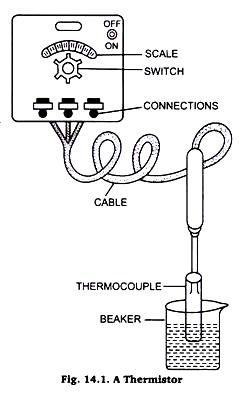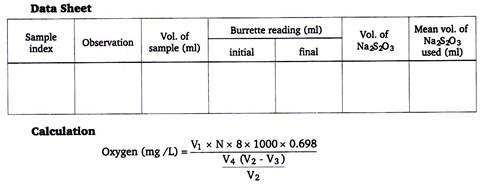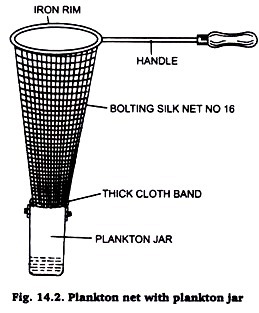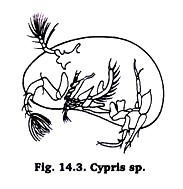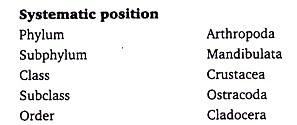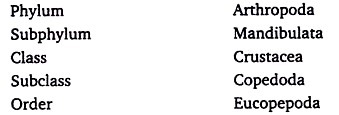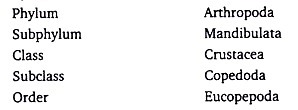In this article we will discuss about the study of abiotic and biotic components of aquatic ecosystem.
Study of Abiotic Aquatic Ecosystem:
I. Collection of Water Sample:
Proper water sample collection is essential for different physical and chemical analyses. A representative sampling is usually done by collecting samples from a number of places from different depths and mixing them together to get a composite sample.
A Kemmerer, Friedinger or Foesst type sampler is used for water collection. Bubbling or mixing with air and other gases and undue agitation should be avoided during collection of samples for estimation of dissolved gases.
ADVERTISEMENTS:
The sampler is connected with a flexible tube fixed at its bottom. After collection, the water is let out through the tube which is connected to a glass tube. Water is allowed to fill the sample bottle slowly. In case sampler is not available, water may be collected in a large beaker or a plastic bucket and transferred to sample bottles by siphon tube.
Precautions:
1. For estimation of dissolved oxygen water is allowed to overflow at least three times the volume of the sample bottle avoiding air bubbles. The sample for dissolved oxygen (DO) should be fixed immediately after collection and preferably analysed on the spot.
2. Analysis of CO2 should be done immediately after collection.
ADVERTISEMENTS:
3. Free ammonia should be analysed on the spot or fixed with a few drops of sulphuric acid and taken to the laboratory.
4. Total alkalinity should be estimated soon after collection, because loss of CO2 from the water may give different result, if analysed later.
5. Determination of temperature, turbidity and pH should be done on the spot.
6. The material to be studied later is fixed with few drops of chloroform or toluene and taken to laboratory, but in no case the analysis be delayed for more than 70 hrs.
ADVERTISEMENTS:
7. The sample should be kept in dark and at low temperature.
II. Salinity Estimation:
Salinity (S) is the grams of dissolved salts (NaCl) in 1000 g sea-water/water. It is expressed in parts per thousand (% or ppt), and ranges from 33 to 38% in the open ocean.
With Salinometer:
Sea-water is an electrolyte and can conduct electric current. Sea-water conductivity is used as an index of salinity. At a given temperature electrical conductivity increases with salinity. Conductivity techniques of salinity estimation are far more accurate than other techniques.
With refractometer:
The refractive index of water is directly related to salinity. Modern refractometers are temperature compensated and provide a convenient tool for measuring salinity. The meter gives accurate measurement of salinity percentage in the field.
III. Measurement of Temperature:
The temperature of water bodies is determined with the help of a Celsius thermometer.
ADVERTISEMENTS:
Celsius thermometer:
A Celsius thermometer is graduated in 0.1°C to 0.01°C scale.
Dip the thermometer directly in the sample and read the mercury level. Record the reading of the thermometer in degree Celsius.
Thermistor (Fig. 14.1):
Thermistor is a dry cell operated or main line operated digital displaying field instrument. Thermistor is available with a temperature probe, either.
Insert the temperature probe in the temperature input socket. Select main or battery as power source. Dip the temperature sensor – a glass globule – into the sample in different depths of water. The temperature is displayed in the digital display meter (potentiometer). Read and record the temperature.
Gases:
Solubility of gas in water depends on the concentration (partial pressure), availability of the gas and temperature. Oxygen is sparingly soluble in water, carbon dioxide is much more soluble about 30 times more than O2.
IV. Estimation of Dissolved Oxygen (DO) (Winkler’s Method):
Reagents:
Manganese sulphate:
400 g MnSO4.2H2O is dissolved in distilled water. Distilled water is added to make the volume 1 litre.
Concentrated Sulphuric Acid (H2SO4):
Starch indicator:
1 g soluble starch is added to boiling distilled water. On cooling required amount of distilled water is added to make the volume 100 ml. Use freshly prepared starch solution in titration.
Sodium thiosulphate (0.025 N):
6.025 g thiosulphate (Na2S2O3) is boiled in distilled water, cooled and distilled water added to make the volume 1 litre. The solution is stored in a coloured bottle. 2 to 3 pellets of sodium hydroxide may be added as a preservative.
Alkaline iodide:
150 g potassium iodide (KI) is dissolved in distilled water. Distilled water added to make the volume 1 litre.
Reaction:
Mn+2SO4 + 2KOH → Mn+2(OH) + K2SO4 [Manganese sulphate reacts with potassium hydroxide: Manganous hydroxide – a white precipitate is formed]
2Mn+2(OH)2 +O2 → 2Mn+4O(OH)2 [A brown manganese basic oxide precipitate is formed in the presence of oxygen]
Mn+4O(OH)2+ 2H2SO4 → Mn+4O (SO4)2+ 3H2O [Sulphuric acid dissolves the brown precipitate yielding manganese sulphate]
Mn+4(SO4)2 + 2KI → Mn+2SO4 + K2SO4 + I2 [Manganese sulphate reacts with potassium iodide to yield iodine]
[O2 oxides Mn+2 to Mn+4 and Mn+4 oxidises I to I2. Iodine is determined titremerically with starch as an end point indicator]
Qualitative Estimation:
Procedure:
1. Water from the bottom of a sampler (p.) is taken in a ground glass stoppered B.O. bottle of about 200 ml. capacity.
2. Open the sample bottle for a short time and immediately add 1 ml manganous sulphate and 1 ml. alkaline iodide in quick succession well below the liquid surface. Re-stopper the bottle, avoid entrapping of air bubbles.
3. Shake the bottle mildly 2-3 times to mix the reagent thoroughly.
4. A precipitate is formed and settles at the bottom indicating presence of D.O.
(a) White ppt.: O2 content little.
(b) Little brown ppt.: O2 content low.
(c) Reddish brown ppt.: O2 content high.
Quantitative Estimation:
Procedure:
Follow the procedure adopted for qualitative estimation (points 1 to 4) resulting in a precipitate of brown manganese basic oxide. Determine the amount of D.O. in the sample water by titration method.
1. Remove the stopper and add 1 ml concentrated H2SO4.
2. With little shaking of the bottle the ppt. dissolves and a clear straw-yellow solution results.
3. Transfer 100 ml of solution to a 250 ml conical flask for titration.
4. Titrate with 0.025 N sodium thiosulphate solution with the help of a burette. A pale stew yellow colour appears.
5. Add 3 to 4 drops of one per cent starch solution. The colour turns blue. Continue titration. The blue colour disappears (end point).
Note the reading of the burrete to ascertain the volume of sodium thiosulphate used.
For accurate result repeat titration several times. Record the readings in data sheet and calculate the mean value.
where V1 = Volume of titrant (ml.)
N = Normality of titrant (0,025)
V2 = Volume of sampling bottle after placing the stopper (ml)
V3 = Volume of manganous sulphate + potassium iodide solution added (ml)
V4 = Volume of fraction of the contents used for titration (ml)
8 = Equivalent lot of oxygen
0.698 = A factor to convert mg into ml (standardisation value)
V. Estimation of carbon oxide (CO2)reagents:
NaOH solution (IN):
40 g NaOH (sodium hydroxide) is dissolved in distilled water. Distilled water added to make the volume 1 litre.
Standard sodium hydroxide = 0.0227 N
phenolphthalein indicator solution.
Reaction:
2NaOH* + CO2 → Na2CO3 + H2O
Qualitative Estimation:
Procedure:
1. 100 ml water from the bottom of a sampler is transferred to a graduated cylinder through a flexible tube.
2. Add 4 drops of phenolphthalein indictor.
3. pH would be above 8 if the sample turns pink.
Conclusion:
Free carbon dioxide is absent in the sample.
Quantitative Estimation (Titrimetic Method)
Procedure:
Following the procedure adapted (points 1, 2) for qualitative estimation. Free CO2 is present if the sample remains colourless.
1. Titrate quickly with 0.0227 N NaOH solution with the help of a burrette, stirring the sample gently with a glass rod.
2. A faint pink colour appears.
Note the reading of the burette to ascertain the volume of sodium hydroxide used. For accurate result repeat titration several times. Record readings in data sheet and calculate the mean value.
Calculation:
N = Normality of titrant (0.0227)
22 = Equivalent lot of CO2
Study of Biotic Aquatic Ecosystem:
A community is an independent association of population of a number of species in an ecological niche. In a biotic community both the plant and animal communities are considered together.
I. Biotic Community:
An aquatic microscopic biotic community is constituted by:
(a) Pelagic forms suspended in water, localised mostly towards the surface, and
(b) Benthic or bottom dwellers attached to the bottom or submerged in mud.
Collection of Plankton:
Pelagic forms:
A. Hand net:
1. The plankton is collected from pond with a hand net (Fig. 14.2).
2. The hand net is conical and the diameter of the mouth is 20 cm. It is made of bolting silk, 120-250 mesh.
3. At the end of the net a glass jar is tied lightly.
4. Collect 50 litre of water from different zone of the pond with a bucket. Filter the samples separately through plankton net.
5. Transfer the plankton collected in the jar (collector) at the end of the plankton net to specimen tube.
B. Drag net:
Pelagic planktons are captured by dragging a plankton net made of fine mesh silk or nylon cloth through water. The planktons in the net are transferred to a container by dipping the inverted net in the water of the container and with repeated flushing of water from above.
Benthic forms:
Planktons are collected by grabbing methods. The bottom soil of a measured area up to a measured depth is scooped out by a grabber. The soil is thoroughly mixed with water and strained through sieves of different meshes and the organisms separated.
Killing:
It is difficult to separate microscopic organisms in live state. They are killed by slow addition of formaldehyde in water, and separated later. The specimens are collected in a watch glass or a petri dish containing distilled water and identified under a field microscope.
Pelagic animals:
1. Daphnia sp.
(a) Body bilaterally compressed.
(b) A bivalve carapace encloses body and appendages.
(c) Carapace drawn into an anterior rostrum and posterior caudal spine.
(d) Eyes large and sessile.
(e) Second antennae large and biramous.
(f) Thoracic appendages 5 pairs and leaf-like.
Systematic position:
2. Cypris sp. (Fig. 14.3):
(a) Body laterally compressed and enclosed in a bivalve carapace.
(b) Eye stalk short.
(c) Antennules and antennae well developed.
(d) Second antennae uniramous.
3. Cyclops sp.
(a) Body elongated with a broad cephalothorax and a narrow abdomen.
(b) Cephalothorax covered with carapace.
(c) Eye single, median and dorsal carapace.
(d) A pair of caudal styles bearing plural setae.
(e) Appendages biramous.
(f) In mature females two lateral ovaries are attached to the abdomen.
Systematic position:
4. Moina sp. (Fig. 14.4):
(a) Body oval, ends in a pair of a caudal style.
(b) Antennae branched.
(c) Rostrum horizontal in position.
Systematic position:
5. Culex larva:
(a) The respiratory siphon long and in the 8th segment.
(b) Posterior part of the abdomen forked.
(c) Palmate hairs absent in the abdomen.
6. Anophelese larva:
(a) The respiratory siphon short and in the 8th segment.
(b) Fork absent.
(c) Palmate hairs present in the abdomen.
Mosquito (Pupa):
The pupa of culex and anophelese have following common features:
(a) Body comma-shaped with cephalothorax and ventrally flexed abdomen.
(b) Abdomen segmented.
(c) Antennae, eyes and respiratory siphon in cephalothorax.
7. Culex sp.:
(d) Colourless.
(e) Palmate, hairs absent.
(f) Respiratory siphon long.
8. Anophelese sp.:
(a) Green in colour with blackish spots.
(b) Palmate hairs present.
(c) Respiratory siphon very short. Systematic position (Mosquitoes)
Phylum: Arthropoda
Class: Insecta
Subclass: Pterygota
Order: Diptera
Benthic animals:
1.Tubifex sp:
(a) Live in a narrow tube of mud and minerals glued together.
(b) Body long, cylindrical and metamerically segmented.
(c) Bundles of branched setae on both ventral and dorsal sides.
Systematic position:
Phylum: Annelida
Class: Oligochaeta
Order: Archioligochaeta
